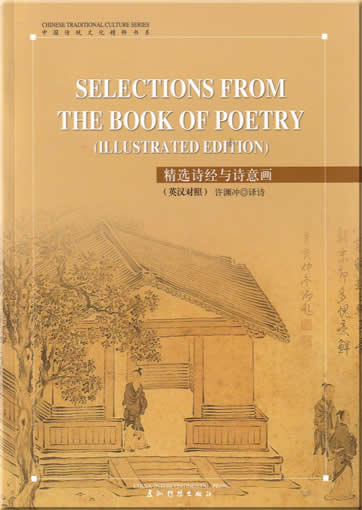|
|
|
Selections from the Book of Poetry (Illustrated Edition) |
|
|
 |
|
Author(s): Xu Yuanchong |
|
Publisher: China Intercontinental Press
Published Date: 2006
ISBN: 7-5085-0887-4
Pages: 196
Language: English-Chinese
Type: Book
Cover: Hard Cover
|
|
Our Price: $36.30
Avail: In-Stock |
|
|

Description
The Book of Poetry, Chinasfirst ancient )em collection, was compiled in the middle of the Spring and Autumn Period, around the 6th cen ury BC, and roughly contemporary with the epics mad and Odyssey by Homer of ancient Greece. At the beginning it was called Poetry, 300 Poems car Collected 300 Poenas. It didn't have its current name until the Western Han Dynasty (206 BC-AD 25) when it was regarded as a Confucian classic and listed in the "Six Classics" along with Collectionn of Ancient Texts, The Rites, The Book of Music, The Book of Changes and The Spring old Autumn Annals.
Its compiler has been usually ascribed to Confucius, ancient Chinese educator. According to Historical Records by Sima Qian, historian of the Western Han Dynasty, prior to Confucius' time_ there were over 3,000 poems in circulation. After strict screening, Confucius saved only and used these and the other five classics as textbooks to teach his disciples.
During the Han Dynasty annotating and teaching The Book of Poetry were four schools, founded respectively by Yuan Gu of the Qi State, Shen Pei of the Lu State, Han Ying of the Yan State. Mao Heng of the Lu State and Mao Chang of the Zhao State. Nonetheless, only the edition annotated by Mao Heng and Mao Chang was handed down to this very day.
Poems included in The Book of Poetry were written approximately between the early years
the Western Zhou Dynasty (11th century BC) and the middle of the Spring and Autumn Period ( 6th century BC), dating back about 2,500 years.
Legend goes that official collectors went on a special mission to solicit folk songs and -3ilads from Gansu, Shaanxi, Shanxi, Hebei, Henan, Shandong and Hubei, and presented them to the imperial court of the Zhou Dynasty. Some other poems in the book are odes to the Zhou king, composed by high court officials and the literati. Impen ions then wrote music for all the poems to amuse the king.
The Book of Poetry divides into three parts: the Book of Songs, the Book of Odes and Epics, -n d the Book of Hymns, consisting of 305 poems.
Contained in the Book of Songs are poems collecte south of the Zhou capital (modern Shaanxi and Henan) and around the capital (modern Henan), south of Shao (modern Henan), in Bei (modern Hebei), Yong (modern Shandong), Wei (modern Henan), Zheng (modern Henan),
Qi (modern Shandong), Wei (modern Shanxi), Tang (modern Shanxi), Qin (modern Shaanxi), Chen (modern Henan), Gui (modern Henan), Cao (modern Shandong) and Bin (modern Shaanxi). This volume includes a total of 160 poems, most of which are folk songs circulated and sung in the Yellow, Yangtze and Hanshui river valleys.
Of the 105 poems in the Book of Odes and Epics, a majority were written by the nobles and sung in the imperial court, only a small part in the Book of Odes were created by folk poets. The Book of Hymns, including hymns of Zhou, Lu and Shang, coisists of 40 sacrificial songs.
The Book of Poem is composed mainly of lyrics, coupled with narrative poems, satirical poems and ballads. It gives a vivid description of various aspects of social life during the Zhou Dynasty, mirrors the sufferings of the people brought about by war and heavy corvee, and extols their pursuing love and freedom. Therefore, the book is both a literary treasure and important data for socio-historical study of ancient China.
Three rhetorical methods -- fu (narration). bi (simile) and xing (borrowed analogy) -- have been used in The Book of Poetry to enhance its power of expression. With high artistic attainments, it has been an imperishable literary masterpiece both in China and the world, and a dazzling pearl in the long river of human history, producing a far-reaching impact on literary creation of later ages.
In history it had become a tradition to illustrate The Book of Poem with pictures or produce works of art themed on its poems owing to the bookscharm and reputation. Of those being handed down, the Illustration of The Book of Poetry transcribed by Emperor Gaozong of the Southern Song Dynasty and illustrated by noted painter Ma Hezhi is perhaps the most widespread one. Its editions have been kept respectively in the Palace Museum of Beijing, Shanghai Municipal Museum, Liaoning Provincial Museum, Palace Museum of Taipei. Museum of Guangxi Zhuang Autonomous Region, Museum of Fine Arts in Boston, Metropolitan Museum of Art in New York and British Museum in London. Some are in the safekeeping of individual collectors.
Famous painter Xiao Yun of the late Ming and early Qing dynasties once copied Masworks and left behind the Illustration of Songs Collected in Chen, which is kept in the Palace Museum of Taipei. Between the fourth and tenth year of Qianlong (1739-1745), the emperor himself and officials in charge of imperial edicts and mandates copied out the whole Book of'Poetrv while imperial painters imitated Masillustrations, resulting in a complete Illustrated Book of Poetry in the EmperorsHandwriting in 30 volumes, which is kept in the Palace Museum of Taipei.
The 51 poems included in this anthology are all representative pieces from The Book of Poetry. Most selected drawings are art curiosities by renowned painters of the previous dynasties, conducive to better understanding of the poems as well as their poetic sentiment.

|
|